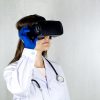
Distance learning is starting to become the norm, with pandemics forcing teaching institutions to quickly develop a plan B to replace in-person activities. This trend has also made a splash in healthcare, with tech company Osso VR attracting a whopping $14 million investment to develop virtual reality solutions for surgical and medical training.
The fund is being driven by Kaiser Permanente, the healthcare juggernaut, which organized a group of investors to provide the bulk of the capital. Osso VR also attracted backing from other investors, both new and old, including known names such as Scrum Ventures, GSR, and SignalFire. There is clear industry confidence in the Palo Alto-based outfit.
Osso VR’s core mission is simple: the company aims to provide cutting-edge medical training using virtual reality technology to provide an immersive teaching experience. The benefits are obvious, especially in the current climate of increased online learning.
The market for online medical education services is in the ascendancy, with Osso VR’s CEO, Dr. Justin Barad, estimating that the industry is worth anywhere between $3 and $5 billion. Considering the recent upshot in demand, experts predict that this figure will balloon in the coming years.
The Problem: 30% of Surgical Graduates Need Help
Dr. Barad saw a clear problem in surgery and it’s a harrowing statistic: right out of grad school, only 70% of surgeons are able to operate independently. And those in training are given less time to undertake the 100 or so cases they must tick off in order to safely handle modern medicine’s complex devices.
And the problem is only getting worse, with a rapidly aging population and a projected shortage of surgeons a realistic scenario. Dr. Barad’s keen interest in gaming and VR tech helped him envision how these technologies could help bridge this training gap.
Osso VR essentially allows surgeons in training to experience surgical procedures in a more realistic and immersive environment. Instead of just watching videos or learning through books, students are able to perform complex procedures from the comfort of their own homes.
The Man Behind It All: Dr. Justin Barad
Barad has an interesting (and somewhat surprising) back story. When he was younger, he didn’t dream of becoming a medical doctor. He’s now a trained orthopedist, yes, but his original aspiration was to become a game developer. His keen interest in gaming inspired him to turn to coding, resulting in a game credit with industry giant Activision/Blizzard.
His interest in gaming never waned, but a family emergency turned his professional attention to medicine. He wanted to use both his medical training and programming experience to help solve practical problems. And that’s how Osso VR was born.
The coding skills that he learned through gaming allowed him to create a viable proof of concept, and he went from there. Without that core skill set, Barad’s idea would probably never have taken off.
How Gaming Fueled VR Tech
Barad’s medical innovations using VR tech would also not have been possible without the gaming industry. This is because Barad is leveraging existing hardware technology, rather than reinventing the wheel.
Virtual reality’s growth and technical improvements have been driven by public interest and demand for improved gameplay and VR tech isn’t just the most accessible, but also the most advanced.
Gaming industry giants have invested millions of dollars into the technology, with big-hitter adaptations like Half-Life: Alyx and Skyrim VR driving development forward. Even VR-only titles are currently being developed for popular series such as Assassin’s Creed and Splinter Cell by Ubisoft.
The VR trend is also turning mainstream and getting attention from industries not usually involved in virtual reality – gambling. And that goes beyond the educational field Osso VR operates in.
Covid-19 has fueled tech development into overdrive, as gamblers, mostly casino players, are increasingly opting for online alternatives. To keep up with the demand, gaming companies that base their businesses online are increasingly recognising the importance of improving their UX experience.
As a result, many online casinos are now offering live dealer games as an alternative to the physical casino spaces that have had to close, their popularity increasing almost in tandem with the technology. Some of the assets of live dealer games come down to the ‘realness’ of the experience. Players can not only interact between themselves, but they can chat to the dealer, as well as tip him or her with real money while playing.
What’s more, recognizing this opportunity, casinos are slowly investing in developing VR options for popular table games like poker and blackjack hoping that in the future an improved VR experience will render land-based casinos completely obsolete. But, since this technology asks for great expenditures, companies are taking smaller steps.
What is sure – VR is the tomorrow of many industries.
When it comes to surgery, according to a study by researchers at the University of California at Los Angeles, medical training with virtual reality gaming technology turned out to be 230 percent more efficient than traditional methods in surgery, as Washington Post reports. What’s more, a multiplayer component that is built to Osso VR straight from multiplayer VR games allows surgeons to work together in virtual reality, which, as Barad says, “can get everyone in the same virtual operating room so you can train as a team and you can practice knowledge of technical skills.” Meaning that surgical training is as fun as playing a video game and as realistic as performing it live.
Expect More In Future
Recent events have changed the learning landscape. Even archaic institutions that were resisting online learning are being forced to make sweeping changes to the way they engage with students.
With VR quickly gaining ground in the gaming industry, expect to see more companies like Osso VR joining in, whether in the sphere of medicine or other academic disciplines. The advantages are clear, the technology is there, and now the investors are smelling the potential.
